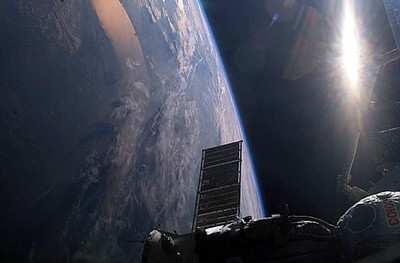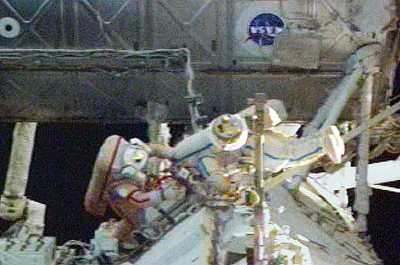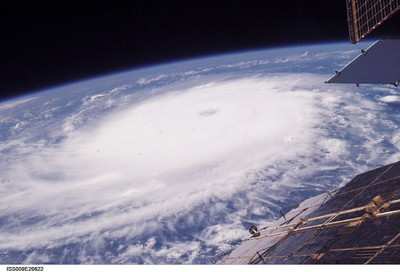What Have We Learned?
Each crew aboard the International Space Station discovers more
and more about what it takes to live and work in space for long
periods of time. This year, the fourth for humans continuously
staffing the Station since the arrival of Expedition 1 on November
2, 2000, has proven to be an exceptional example.

"Every challenge for the International Space Station crews,
flight control teams and management adds to the knowledge base we
need to develop longer spaceflight missions to places like the moon
and Mars," said Bill Gerstenmaier, International Space Station
program manager. "The work we're doing on Station is directly
connected to future exploration missions."
International cooperation grew even closer during Station
operations this year, particularly in the planning and execution of
spacewalks. In February, the Expedition 8 crew, Commander Michael
Foale and Flight Engineer Alexander Kaleri, conducted the first
spacewalk from the Station by a two-person crew, without a
crewmember left inside. The spacewalk demonstrated these types of
spacewalks, using the procedures developed by American and Russian
flight controllers working together, could be safe and
successful.
Two spacewalks were planned for the next crew, Expedition 9
Commander Gennady Padalka and Flight Engineer Michael Fincke.
Within days of their arrival, a breakdown of an external Station
component added a third spacewalk to their mission. Then, problems
were found in the US spacesuits, and international cooperation came
through again. Teams worked out procedures for the crew to wear
Russian spacesuits to work on the US side of the complex. They
worked closely to combine tools and procedures, even switching
between control centers and languages, to complete the successful
repair.

Astronauts living aboard the Station have been invaluable in
maintaining the facility. With no Space Shuttles to deliver
supplies since the Columbia accident in February 2003, repair parts
have been shipped via the smaller Russian Progress resupply
vehicle. Fincke demonstrated US spacesuits could be taken apart and
repaired in space. Normally, a Shuttle would have delivered whole
new suits as replacements. Fincke's work, continued by Expedition
10 Commander Leroy Chiao, will restore two US spacesuits to
operation.
Foale and Kaleri used a small set of tools to perform the
unprecedented repair of a stabilizing gyroscope in their exercise
treadmill. A new gyroscope would have been too large to deliver
aboard a Progress. "The crews have shown repairing hardware in
space with few supplies and equipment is possible," Gerstenmaier
said. "Missions far from Earth will benefit from their work," he
added.
Research on the Station this year was refocused to directly
support the Vision for Space Exploration, with human life science
experiments taking on highest priority. One such experiment was the
Advanced Diagnostic Ultrasound in Microgravity (ADUM). It was used
to develop the remote medical diagnostic and telemedicine
capabilities needed by crews on distant exploration missions.
Another experiment, called FOOT, evaluates the exercise forces
necessary to maintain muscle and bone health on long-duration
missions. A related experiment, called Biopsy, continues to study
some of the basic fundamental principles involved in muscle atrophy
that occurs during spaceflight.

Along with tackling technical tasks, ground support teams did
their best to make the astronauts feel at home in space. Mission
Control, Houston, kept Fincke in touch with his family as his wife
gave birth. Fincke was able to talk from space to his wife using an
Internet protocol telephone and private family conferences via
satellite.
Chiao cast the first vote in a presidential election from 230
miles above Earth. Through a special law passed in Texas in 1997,
astronauts are able to vote electronically from space. Chiao
submitted his electronic ballot to his county clerk's office via
email.
Another milestone in spaceflight was reached this year when
Foale accumulated more time in space than any other US astronaut.
He logged 374 days, 11 hours and 19 minutes during his Station and
previous missions. The astronauts and cosmonauts serve as test
subjects, blazing a trail in understanding what happens to the
human body while living without gravity for long periods.

Chiao and Expedition 10 Flight Engineer Salizhan Sharipov will
continue to maintain hardware and conduct scientific research for
the next six months. The Station has been under construction for
six years, since the arrival of the first element, the Russian
Zarya module, in 1998. Major assembly is set to resume with the
return of the Space Shuttle to flight next year.
 ANN's Daily Aero-Linx (04.15.24)
ANN's Daily Aero-Linx (04.15.24) Classic Aero-TV: 'No Other Options' -- The Israeli Air Force's Danny Shapira
Classic Aero-TV: 'No Other Options' -- The Israeli Air Force's Danny Shapira Aero-News: Quote of the Day (04.15.24)
Aero-News: Quote of the Day (04.15.24) Airborne 04.16.24: RV Update, Affordable Flying Expo, Diamond Lil
Airborne 04.16.24: RV Update, Affordable Flying Expo, Diamond Lil ANN's Daily Aero-Term (04.16.24): Chart Supplement US
ANN's Daily Aero-Term (04.16.24): Chart Supplement US






